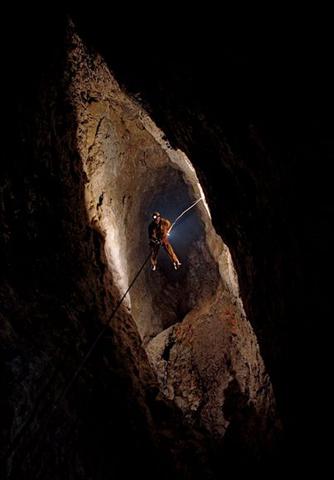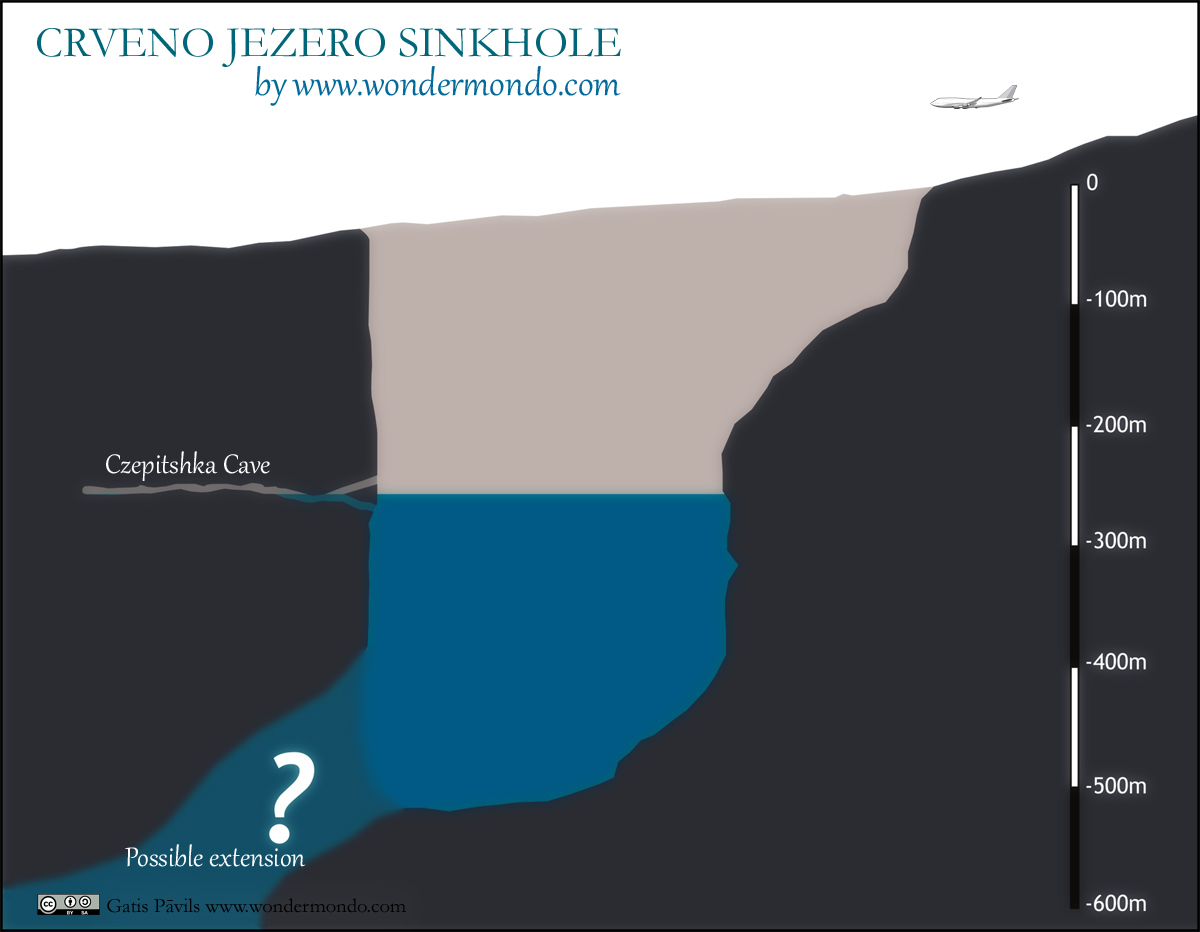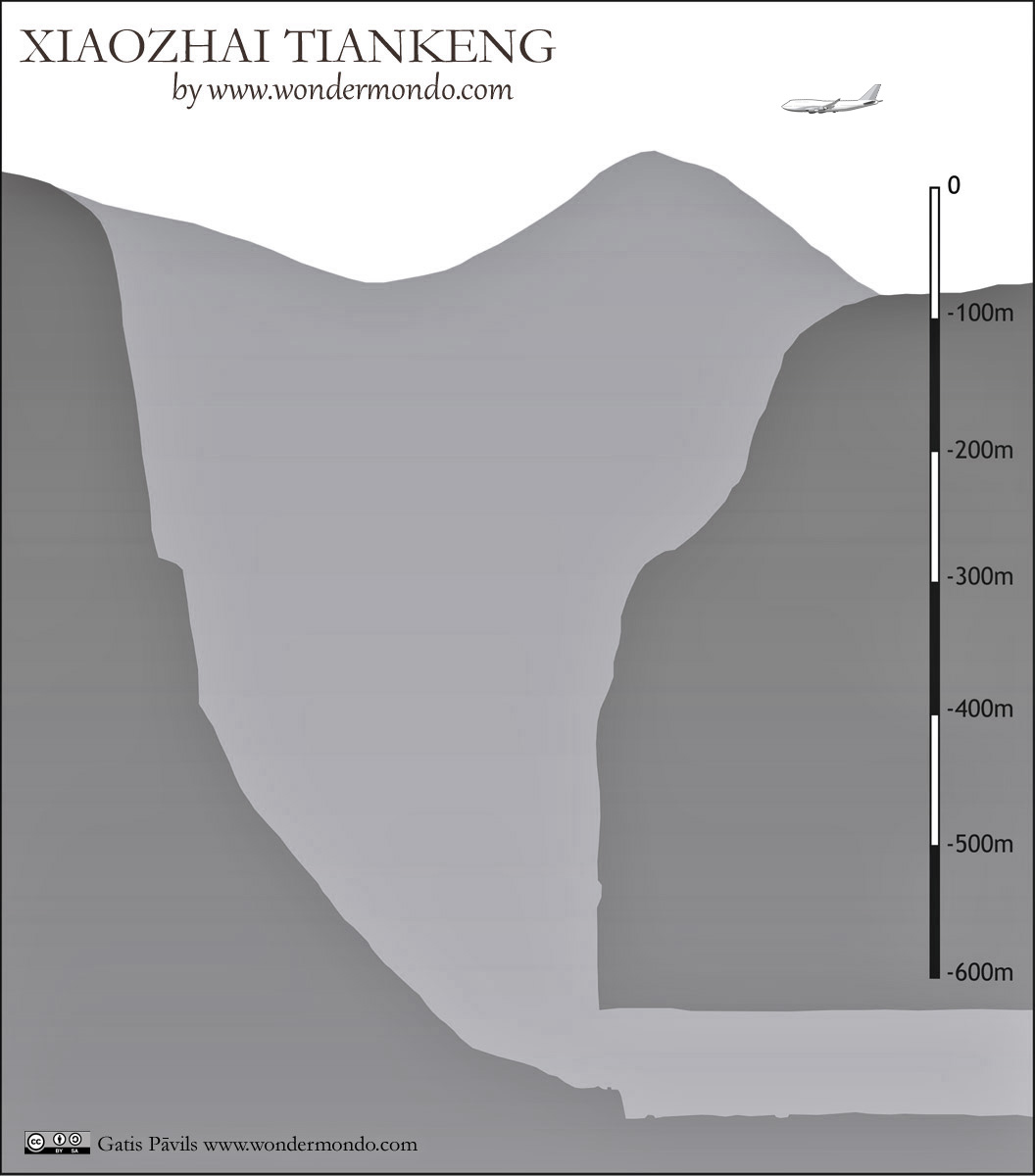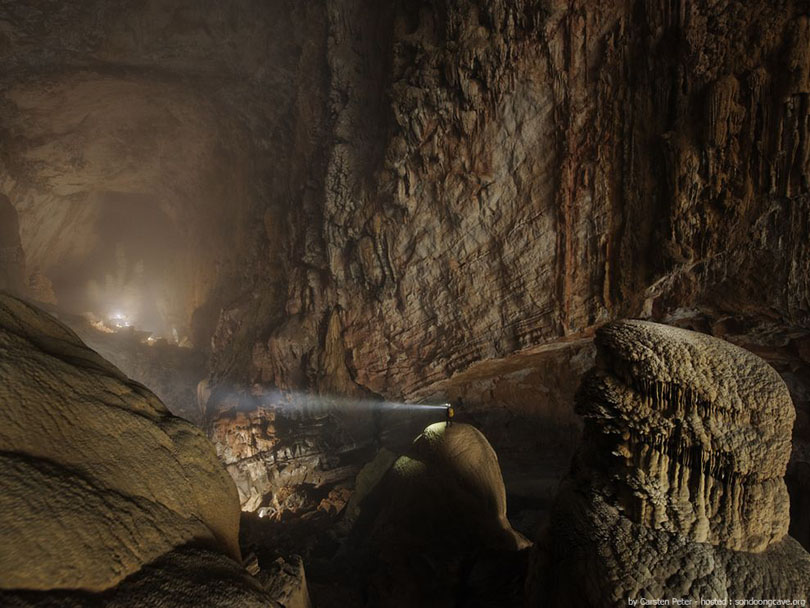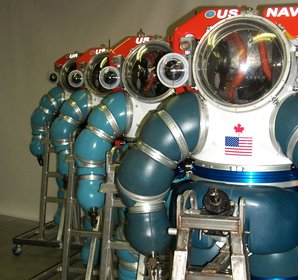
Speleology and space flights are significantly equivalent from a certain point of view. There is not that big difference between a speleologist deep inside a cave and an astronaut situated in space - both discover unknown spaces, species or organisms and enter places where literally nobody has gone before. For both the journey back to the surface of the planet Earth requires spending hours or days of a risky and perilous effort. This parallel is particularly true for cave divers, due to additional barriers imposed by the aquatic element - such as high pressure environment, unpredictable underwater currents, restricted visibility, and limited breathing resources inevitable for operating in this human-unfriendly environment. The following lines deal with an unexpected discovery revealed by speleodivers in a geologically extraordinary cave. Instead of being located in speleologically famous countries like Venezuela, Vietnam, China or Mexico, the cave surprisingly lies in ... the Czech Republic. If you are interested in exploration of not only the outer space but also the planet Earth's deep underground, then you are at the right place now. Read further about the spectacular recent discovery which will yet continue in the following years, perhaps beating the current world depth record (for the latest July 2017 update [video included] see the end of the article).
The beginning of the story was anything but unusual. Known by local residents from the ancient times and situated only few hundred meters from the Bečva na Morave river (Czech Republic) there lies an abyss called Hranice. Having a funnel shape with almost 70 meters depth it is an interesting although in no way unique natural object. One wouldn't expect any outstanding discoveries at this locality even from a single trivial reason - it is situated only 300 meters from a railway station, being de facto only a small spot in the middle of fields, roads and villages. It's neither a distant wildwood place, where you are brought and navigated by a local farmer after a day long and exhausting journey through a deep jungle, nor a hidden natural object kept secret by native tribes. Who would expect fascinating discoveries here? Nevertheless... the nature has surprised us.
Figure 1: Hranice Abyss is situated only 300 meters from the 'Teplice nad Bečvou' railway station (GPS: 49.5321685,17.7505857). Relatively unconventional location for a world class cave.
Bottomless funnel.
The abyss has an inclined funnel shape, with a small lakelet lying 69.5 meters below the surrounding terrain. The lakelet was believed to be shallow for a long time and although nobody had reached the bottom, the general shape did not suggest any hidden surprises indeed. Thus, no systematic exploration had taken place there, except an event in 1902 when a simple lead probe was dropped down from a boat, stopping at 36 meters depth. Seemingly an appropriate figure, no indication for any uniqueness. Consequently, no significant activity took place afterwards. The turnaround came with introduction of divers - in 1961 they sank into decent six meters at first, three years later into 60 and in 1966 surprisingly into ... 82 meters. Thus, the depth of the water in the lakelet already surpassed the depth of the dry part of the abyss. It became apparent that the lakelet is in no way a usual pond. Year 1968 - 88 meters reached... and the bottom still far away, not seen in spite of a clear water with 20 meters visibility. However, the reached area was already on the edge of speleodiving technology. Therefore, a probe was employed in 1974, bringing researchers into 175 meters depth. Still not reaching the bottom. Due to narcotic effects of high pressure nitrogen (similar to alcoholic intoxication - divers are losing orientation and judgment abilities, often removing breathing regulator from their mouth, etc.) it is not possible to safely reach such depth with the standard air as a breathing medium. The divers switched to a mixture of helium, nitrogen and oxygen (so called trimix). However, it was not sufficient - the dive reached 110 meters in 1981, 134 meters in 1992, and 155 meters a year later. It was time for another probe - a sophisticated remotely controlled robotic one. In 1995 it descended into 205 meters depth, encountering a narrow space blocked by tree logs, branches and boulders. The robotic probe got stuck there and its operator must have spent significant effort in order to relieve it. Afterwards, in spite of carrying it successfully out of the narrow passage, it entangled into the leading rope, getting out of control in depth where no available diver could descend. Fortunately for the Belgian sponsor the probe was finally pulled out manually using the power cable to the depth of 60 meters where it was finally saved by the divers...
Figure 2: Funnel-shaped abyss known from the ancient times is undoubtedly worth of paying attention, however, an extrapolation of the wall directions suggests the lakelet at the bottom to be shallow, not hiding any ground-breaking surprises. Nevertheless, as it applies to all natural sciences - even the smallest and negligible part of the object or system can hide unexpected discoveries leading to entirely new horizons, and nobody can be sure unless all omitted parts are explored. Credit: hranickapropast.cz
Robot versus human
The probe is not able to descend further, but the explorers do not give up - where the robot failed, perhaps human will succeed. The next attempt took place in 2000 - the result: 181 meters reached by the Polish professional Krzysztof Starnawski. However, that was the best what could have been achieved with the technology employed. No possibility of going deeper. More than a decade must have passed till Starnawski - after years of training, preparations and equipped with new technology - returned to the spot in 2012, firmly determined to reach the bottom. In June he reached the narrow passage which had stopped the robot, and ... he passed through successfully! This demanding procedure involved grazing the body against the logs and branches, endangering the diver by their possible shift and increasing the risk of cutting the way back. What an admirable courage and will - imagine yourselves being in 205 meters depth, the way back taking seven hours due to decompression. As a consequence of high pressure the human tissue absorbs high amounts of gases which subsequently need to be released slowly through the lungs during the ascend. Thus, each minute spent in such a depth means approximately 30 minutes of decompression, otherwise one would painfully die or become paralysed due to blocking of small blood vessels and capillaries by the gas bubbles. You are in such a depth, nobody is able to help you if needed (for the only one there with the necessary equipment and training capable of reaching such depths are yourselves). Relying only on the technology and his skills and judgment - similarly to astronauts on the Moon - Starnawski forced himself through the unstable logs and branches... Citing another professional speleologist's appreciation - most of cave divers would not manage this passage even in 40 meters depth...
Figure 3: Narrow passage in 205 meter depth blocked the robot. Human has passed through successfully, however. Exceptional training, sophisticated equipment, and tough mind was essential. Credit: Krzysztof Starnawski.
Journey into the Unknown continues
The discovery of the passage was not the most interesting fact, however. After the passage the abyss widened significantly again so that despite the clear water Starnawski was able to see neither bottom nor the side walls. That was an irresistible challenge for any genuine explorer. Starnawski returned after three months, pushing through the narrow passage again (carefully observing any changes in stability of the obstructions), this time with calibrated 164 meters long rope, releasing it into the abyss. The rope was reeling off, disappearing into the darkness for about two minutes, the reel getting thinner quickly... finally stopping at unexpected 150 meters. The overall confirmed depth thus reached 373 meters + 69.5 meters dry part...
 Figure 4: Krzysztof Starnawski: "There is no need for leaving the Earth gravity. In the depths you have feelings similar to those of astronauts during extravehicular activity". It applies twofold during his 200+ meters depth dives.
Figure 4: Krzysztof Starnawski: "There is no need for leaving the Earth gravity. In the depths you have feelings similar to those of astronauts during extravehicular activity". It applies twofold during his 200+ meters depth dives.
Right: HD video capturing the record dive, including surmounting the narrow passage and reeling off the rope in the deepest part. Credit: dualrebreather.com
Figure 5: Scheme of the Hranice Abyss after the recent discoveries. Only 19 meters are missing to become the world's deepest underwater cave. According to geologists there are solid scientific reasons to think the explorers will pass through this threshold easily. Credit: dualrebreather.com
Due to the drop of the rope being only a random attempt in the vicinity of the abyss walls there is high probability of rope not hitting the genuine bottom. The abyss may continue even deeper. For this statement there exists a solid geological argument - the abyss was created in the Devonian limestone (consisting mostly from metamorphosed marine life shells during the geological period called Devonian, 419 - 359 million years ago), with overall thickness of 700-1000 meters in that area. Minor cracks and disruptions were created in this layer after the collision of the African and Eurasian tectonic plates, allowing the relatively warm (16-20°C) mineral waters saturated with high levels of carbon dioxide (being a weak H2CO3 acid) to penetrate from below, efficiently dissolving the limestone. The abyss was thus created by the acidulous water from below, unlike most of the caves which are created by significantly less acidic rain water. For this reason it is highly probable that this void with an unusual origin may continue to the very base of the limestone geological layer, lying at least 700 meters below the surface.
Challenge
Is there more promising and tempting vision for a genuine explorer? Krzysztof Starnawski is determined to return to the site and continue the exploration. The next step is clearing and stabilizing the narrow passage, for despite the modern technology it is too risky to stay behind. For a better understanding of the technology let's take a closer look at it - modern divers use highly sophisticated breathing system. Not only they are breathing a mixture of helium, oxygen and nitrogen with various abundance depending on the depth, but they use a closed breathing circuit (so called rebreather) which recycles the exhaled gas through filters absorbing the carbon dioxide instead of releasing the gas to the surrounding environment. This enables breathing the same mixture multiple times while only resupplying the oxygen in order to maintain its necessary level. There are two major advantages of this technology - first, the diver does not exhale any gas, i.e. not releasing any bubbles, thus not causing any unwanted stirring of the environment surrounding the diver. This is beneficial especially in restricted and sediment-covered cave spaces, keeping the visibility of the water at a sufficient level (speleodiving already claimed not a few lives due to the loss of orientation caused by stirring of the environment). Our diver-astronaut analogy thus becomes even more realistic. The second advantage of the rebreather is significantly more efficient use of the gas (only the oxygen is consumed, unlike the circulating helium and nitrogen), freeing the diver from necessity of carrying many heavy weight pressurized gas containers. He can thus spent more time underwater and explore further or deeper. In spite of these benefits, the physical and biological laws given by the extreme pressure in great depths cannot be avoided. Having in mind the above-mentioned ratio of 1 minute spent in 200+ meters depth requiring 30 minutes of decompression, nobody can afford any delays or complications. Not mentioning the perils of a complete getting stuck in the passage or general dangers of oxygen toxicity, nitrogen narcosis or high-pressure neurological syndrome (HPNS) which also claimed lives of many professional deep-divers.
Figure 6: Dependency of the diver's depth and the elapsed time (red curve) - we can see the quick descend, brief stay in the maximum depth and hours of slow decompression afterwards... Credit: hranickapropast.cz
Further discoveries from this promising locality are awaiting and they will probably bring a lot of exciting news in the near future. Hranice Abyss has already surpassed the depth of the more famous underwater El Zacatón cave in Mexico (319 meters), and only 19 meters are missing to surpass the world's deepest currently known underwater cave - 392 meters deep Pozzo del Merro cave situated in Italy, only 23 kilometers from Rome (see photo, scheme). Both of these geological siblings were explored by the same robotic probe and lie in the vicinity of densely populated areas. Moreover, both of them are results of the same process - warm acidic water ascending from below. For its bottom has not been discovered yet too (more accurately, there is an unexplored horizontal passage in Pozzo del Merro in 392 meters depth), it is definitely to be a noteworthy discovery duel.
Hranice Abyss in the context of other records
Although being a candidate to the world record, Hranice Abyss is not the only place causing excitement in an explorer's mind. Another one is, e.g., the story of the world's deepest known (dry) Krugera cave (often called Voronya cave alternatively, meaning The Crow cave) in Caucasian Abkhazia (see the map in Figure 7 - column A, row 1 and photographs in the fields A2 and A3). Reaching its deepest currently known passages requires several days long and challenging journey - including surmounting of several sumps (siphons) 2197 meters below the surface entrance, i.e. almost at the water level of the nearby Black Sea. Moreover, there is nonzero probability that the cave continues several hundred meters deeper, for it was created during the so called Messinian Salinity Crisis when the Mediterranean and Black Sea were almost completely desiccated. Nowadays, these deepest passages are submerged.
Among other noteworthy examples let's mention the deepest known 513 meters high vertical pit (i.e. place where a rope would freely hang without touching the walls) situated in Velebita cave in Croatia (see photo C2 and map C1), or the highest underground waterfall (440 meters) in Vrtoglavica cave in Slovenia (see its scheme). Not staying far behind there is 290 meters deep Croatian Crveno jezero (with variable depth depending on the season, perhaps with an undiscovered continuation), with its water level itself lying impressive 240 meters below the surrounding terrain (photo B1 - please notice the size of the trees above the abyss; video and scheme B2). There are also other record breakers - the largest and indeed monstrous (5000 x 200 x 150 meters) underground dome discovered in 2009 in the Sơn Đoòng cave in Vietnam (photo C3 and 3D video), or the deepest sinkhole - Xiaozhai tiankeng in China (photo D3 and scheme D2) - created by a collapsed cave roof, and offering a haven for large amount of endemic (i.e. nowhere else occurring) plants and animals - thus some kind of a reverse case of the South American mesas. The largest natural crystals (12 meters long, weighting 55 metric tons) ever found are lying in the Cueva de los Cristales cave in Mexiko (photo B3, documentary).
Nevertheless, the record breaking objects must not necessarily be situated in (sub)tropical regions only - one of the largest stalagmites (although not the largest one any more) can be found in Krásnohorska cave in Slovakia (photo D1 and description in Slovak).
| A | B | C | D | |
| 1 |
Voronya scheme |
Crveno jezero |
Velebita scheme |
Krasnohorska cave stalagmite |
| 2 |
Voronya |
Crveno jezero scheme |
Velebita |
Xiaozhai tiankeng scheme |
| 3 |
Voronya |
Cueva de los Cristales |
Sơn Đoòng |
Xiaozhai tiankeng |
Figure 7: Small gallery of the great speleological beauties. Do not miss especially the enormous Sơn Đoòng cave - click the picture for the full resolution, take a while to look at it, perceive the immense underground spaces and imagine that it is yourself who stays there in that fascinating world. Credits [column, row - credit]: [A1 - Caving club Aenigma] [A2, A3 - National Geographic] [B2, D2 - wondermondo.com] [C1, C2 - speleologija.hr] [B1, D3 - wikimedia] [D1 - krasnohorskajaskyna.sk] [B3 - odysseum.com] [C3 - sondoongcave.org]
The list of speleological records can be long. Nevertheless, for a genuine discoverer any passage with an unknown end in any small and 'negligible' cave is equally interesting, for it is just here where the journey itself is the aim applies. The mystery of the unknown disappears after discovering the end of any cave regardless of its size.
Conclusion
Inaccessibility is the essential and primary feature and the reason for uniqueness of the Hranice Abyss. Whilst the other caves (perhaps except the submerged parts of the Voronya cave and due to the extreme heat dangerous parts of the Mexican Crystal cave) are challenging mostly with respect to the courage, training and sufficient determination and curiosity needed for their exploration, Hranice Abyss is balancing at the human technological and biomedical frontiers. Only sophisticated robotic vessels and special pressurized diving suits could descend deeper - however, their applicability there is severely limited and hindered by the obstruction in 205 meters depth.
Figure 8: Left: US NAVY employs the so called Hardsuit ADS (Atmospheric Diving System) for deep diving, certified up to 610 meters depth. Credit: US NAVY.
Right: Nuytco Research Company has rich experience in developing of the deep-diving exoskeletons – their products passed tests up to 900 meters depth, including the newest Exosuit ADS model displayed in the picture. Credit: Nuytco Research Ltd.
In any case, the equivalence of the deep diving and space research was precisely demonstrated by a robotic vessel used by NASA for 3D mapping of the already mentioned El-Zacatón in Mexico (created, by the way, in sediments at the rim of the former crater which is assumed to be associated with the dinosaur extinction). Similar robots are intended to be used for exploration of supposed oceans on the Jupiter's Europa and Saturn's Enceladus moons as well. Finally supporting this parallel let's mention that we already know caves on the Moon (created by a collapse or breaking of the surface of former lava fields, similarly to various places on the Earth), and even on Mars. Speleology, including the extraterrestrial one, undoubtedly has a bright future.
Figure 9: Caves on the Moon (left) and Mars (right). Being created mostly by a collapse of the magma field roofs, many of them may continue further into horizontal passages, similarly as it is in the case of lava caves on the Earth. Credit: NASA/JPL Lunar Reconnaissance Orbiter (left), NASA Mars Reconnaissance Orbiter (right).
Appendix
The real science is no less thrilling and exciting as any fiction (and we hope this article has supported this fact), yet let's add a small relevant bonus - 22 minutes short science fiction movie Unearthed depicting a fictional moon cave, with the right atmosphere of discovering the unknown and an interesting finale...
Author: Juraj Kotulič Bunta, Ph.D
(LinkedIn)
Primary sources:
Note:
Due to the lack of English speaking resources dealing in detail with the Hranice Abyss available at the time of writing this article, the lines above are a translation of the original article written in the Slovak language, prepared by the author in order to popularise this world-class natural object to the wider readership.
Dec 2014 update:
 Another deep dive has been undertaken by Krzysztof Starnawski and his Czech support team in autumn 2014. Unfortunately, the original passage in 205 depth turned out to be collapsed already, nevertheless, an alternative route has been found, enabling Krzysztof to pass through successfully again. Afterwards, a more sophisticated method - sonar - was used to measure the pitch black depths of the abyss underneath. Result - astonishing 384 meters! Eleven meters deeper than the last measurement. Starnawski with his team intends to return in the beginning of 2015 - this time in order to surpass 400 meter threshold, for it is highly probable that even the sonar measurement has not reached the ultimate bottom of the cave yet. Keep our fingers crossed for expanding the frontiers of our knowledge and understanding - both those of the Nature as well as of capabilities of the human organism enhanced by modern technologies. And perhaps we might witness a change in the world's deepest cave list too - although being negligible for the Nature, it could be the source for new motivation and popularisation of the topic among public. Will the remaining eight meters be ever surpassed? We'll see soon...
Another deep dive has been undertaken by Krzysztof Starnawski and his Czech support team in autumn 2014. Unfortunately, the original passage in 205 depth turned out to be collapsed already, nevertheless, an alternative route has been found, enabling Krzysztof to pass through successfully again. Afterwards, a more sophisticated method - sonar - was used to measure the pitch black depths of the abyss underneath. Result - astonishing 384 meters! Eleven meters deeper than the last measurement. Starnawski with his team intends to return in the beginning of 2015 - this time in order to surpass 400 meter threshold, for it is highly probable that even the sonar measurement has not reached the ultimate bottom of the cave yet. Keep our fingers crossed for expanding the frontiers of our knowledge and understanding - both those of the Nature as well as of capabilities of the human organism enhanced by modern technologies. And perhaps we might witness a change in the world's deepest cave list too - although being negligible for the Nature, it could be the source for new motivation and popularisation of the topic among public. Will the remaining eight meters be ever surpassed? We'll see soon...
Source: National Geographic Poland
July 2017 update:
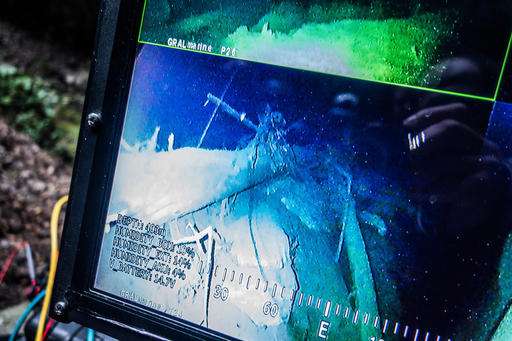
 The next record human dive took place in August 2015, reaching astounding 265 meters below water level (you can also watch the breathtaking dive video), during which Krzysztof Starnawski probed the deeper parts of the cave, confirming the continuation of the cave for at least one hundred more meters - far beyond the capabilities of a human being in these conditions. Therefore, a robot was needed instead, taking part in the research after necessary arrangements and the device construction more than a year later - in September 2016. The custom-built robot (ROV GRALMarine) penetrated successfully the pitch-black depths of the cave in its first testing attempt, stopped only by the length of its fiber-optic cord, diving 404 meters without reaching the bottom (see also video coverage of this literally groundbreaking endeavour). The deepest known underwater cave in the world was officially confirmed (and the title of this article was accordingly modified). Nevertheless, the stubborn cave is still refusing to reveal its secrets, motivating the explorers to boost their effort. The robot got stuck during its returning path just at the critically restricted bottleneck in 197 meters, known from the previous dives. Afterwards, three attempts to free it have failed - the first due to long rains making the surrounding area muddy thus preventing the divers from transporting the necessary equipment close to the abyss, second one due to illness of Krzysztof Starnawski, and finally the third attempt failed because of an unexpectedly low visibility in the water (caused probably by changes in atmospheric pressure or by the nearby quarry activity). The final fourth attempt took place in July 2017, with the help of another underwater robot ROV Falcon, and its success gives us a new enthusiasm for the following months and years - for this is one of the few occasions where we gladly see the warning message 404 Floor Not Found detected by a technical device :-)
The next record human dive took place in August 2015, reaching astounding 265 meters below water level (you can also watch the breathtaking dive video), during which Krzysztof Starnawski probed the deeper parts of the cave, confirming the continuation of the cave for at least one hundred more meters - far beyond the capabilities of a human being in these conditions. Therefore, a robot was needed instead, taking part in the research after necessary arrangements and the device construction more than a year later - in September 2016. The custom-built robot (ROV GRALMarine) penetrated successfully the pitch-black depths of the cave in its first testing attempt, stopped only by the length of its fiber-optic cord, diving 404 meters without reaching the bottom (see also video coverage of this literally groundbreaking endeavour). The deepest known underwater cave in the world was officially confirmed (and the title of this article was accordingly modified). Nevertheless, the stubborn cave is still refusing to reveal its secrets, motivating the explorers to boost their effort. The robot got stuck during its returning path just at the critically restricted bottleneck in 197 meters, known from the previous dives. Afterwards, three attempts to free it have failed - the first due to long rains making the surrounding area muddy thus preventing the divers from transporting the necessary equipment close to the abyss, second one due to illness of Krzysztof Starnawski, and finally the third attempt failed because of an unexpectedly low visibility in the water (caused probably by changes in atmospheric pressure or by the nearby quarry activity). The final fourth attempt took place in July 2017, with the help of another underwater robot ROV Falcon, and its success gives us a new enthusiasm for the following months and years - for this is one of the few occasions where we gladly see the warning message 404 Floor Not Found detected by a technical device :-)
[The picture left shows the deepest part yet achieved - 404 meters. Source: Phys.Org. The picture right shows happy diver David Cani after successfull rescue action on July 11, 2017. Credit: Helena Vysoka]
Source: National Geographic
- Ak chcete pridať komentáre, tak sa musíte prihlásiť
- prečítané 41821x
-











